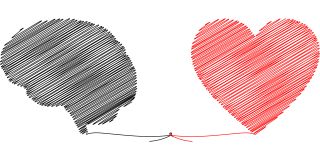Resilience
Monitoring and Training Heart Rate Variability After Brain Injury
Brain injury can impair HRV, but technology may help monitor it.
Posted January 24, 2023 Reviewed by Gary Drevitch

Measuring heart health isn’t only for those who've had heart failure, but also critical for those with traumatic brain injury (TBI). Heart rate variability is a key measure of heart health. As you inhale, your heart rate increases and the time between beats decreases; as you exhale, your heart rate decreases, and the time between beats increases. This variability of time between beats and how well your heart rate rises and falls in sync with your inhalations and exhalations is heart rate variability or HRV. Conder and Conder wrote:
“It is well-established that lack of HRV implies cardiopathology, morbidity, reduced quality-of-life, and precipitous mortality. On the positive, optimal HRV has been associated with good cardiovascular health, autonomic nervous system (ANS) control, emotional regulation, and enhanced neurocognitive processing.”
Brain injury can substantially reduce HRV by damaging the ANS:
“Dysfunction of the autonomic nervous system (ANS) has been found to induce abnormalities in organ systems throughout the body, and may contribute to cardiovascular dysregulation and increased mortality. Autonomic dysfunction, also known as dysautonomia, has been studied in moderate and severe TBI, and has emerged as a major contributing factor in the symptomatology in mTBI as well. Analysis of the ANS has been studied through changes in heart rate variability (HRV)…” (Esterov and Greenwald, Autonomic Dysfunction after Mild Traumatic Brain Injury, 2017)
This is why more clinicians are monitoring HRV in people with brain injury of any cause, for it isn’t only traumatic brain injuries that can impair HRV. They may also try to improve HRV by teaching the client with brain injury how to deep-breathe. Deep breathing, alone or using apps like HeartMath, theoretically improves HRV in brain injury by rebalancing the parasympathetic with the sympathetic nervous systems in the ANS. Conder and Conder cited studies on using biofeedback on non-injured subjects to increase HRV. But their conclusion presupposes that the impaired stress response from brain injury can be rebalanced in the same way that people without this injury can.
In my experience, it can’t.
Shortly after my brain injury, the treating psychologist taught me to deep breathe. Years later when I attended brain biofeedback, their HRV screen showed my deep breathing to be “perfect.” Yet my heart rate was erratic and HRV could not be trained—not then, and not years later when HRV training had become a standard part of brain biofeedback. Only two treatments showed promise in improving HRV: gamma brainwave enhancement and photobiomodulation therapy as devised by Dr. Fred Kahn. In other words, repairing injured neurons and rebooting the microglia through particular kinds of neurostimulation or neuromodulation can restore HRV after brain injury. But we can’t know exactly what kind and for how long without proper studies.
Without treating the brain injury, is it useful to monitor HRV?
Cardiovascular endurance or cardio fitness reflects how well your body can use the oxygen you breathe in during exercise. Aerobic exercise increases your heart rate and breathing and improves HRV. As lifting weights does for muscles, the more you walk briskly or run, the fitter your heart will become. But what happens when your brain injury induces fatigue and high heart rate from standing up or answering the phone or eating? What happens when exercise worsens brain injury symptoms including HRV? Or impaired concentration and memory results in forgetting to use an HRV app? Or HRV resists improvement from deep breathing and HRV training?
Moving is important for anyone. Before you can treat a brain injury effectively, you must understand it. That includes your baseline heart health. A number of research centres now use the Apple Watch in their heart health studies, including the University Health Network in Toronto, to give heart failure patients control over their health and to allow doctors to monitor their patients’ hearts. Dr. Heather Ross is leading a study to “see if Apple Watch health sensors and features, including the Blood Oxygen app and mobility metrics, can provide early warning for worsening heart failure.” (Learn more here.)
As it benefits heart failure patients, the Watch can help people with brain injury as well. It passively records HRV, blood oxygen levels, and cardio fitness as well as allowing manual recording when symptoms arise. There's no need to remember to run an HRV app or add one more health job to a crowded medical day. A person can share these daily life health metrics with their doctor. Health care professionals providing neurostimulation or neuromodulation can see how treatments are improving their client's HRV over time (or not) and adjust accordingly.
Combined with a fitness app, the Watch can also help a person exercise. A workout can be dusting a shelf for 5 minutes; the Watch won’t make them feel like a failure for having such minimal physical effort counted as exercise since there’s no peer expectations involved. Apple’s fitness awards and voice alerts can help motivate when a person with brain injury exercises alone. The Watch speaking out split times replaces the need to remember to check and it gives the brain the illusion that someone is with them. Such an illusion is all the brain needs to make one feel less alone.
The key is to not set yourself up for failure. A smartwatch that measures HRV passively empowers a person with the foundational information they need to improve their heart health post-brain injury. They can use it to provide proof of which treatments work to improve their HRV and heart.
Copyright ©2023 Shireen Anne Jeejeebhoy
References
Conder, R., & Conder A. (13 August 2014). Heart rate variability interventions for concussion and rehabilitation. Front. Psychol., Sec. Psychology for Clinical Settings. Volume 5 - 2014. https://doi.org/10.3389/fpsyg.2014.00890
Esterov D, & Greenwald BD. (11 August 2017). Autonomic Dysfunction after Mild Traumatic Brain Injury. Brain Sci. 7(8):100. doi: 10.3390/brainsci7080100. PMID: 28800081; PMCID: PMC5575620.
Heart Rate Variability. Standards of Measurement, Physiological Interpretation, and Clinical Use. Task Force of the European Society of Cardiology the North American Society of Pacing Electrophysiology. Originally published 1 Mar 1996 https://doi.org/10.1161/01.CIR.93.5.1043 Circulation. 1996;93:1043–1065.




